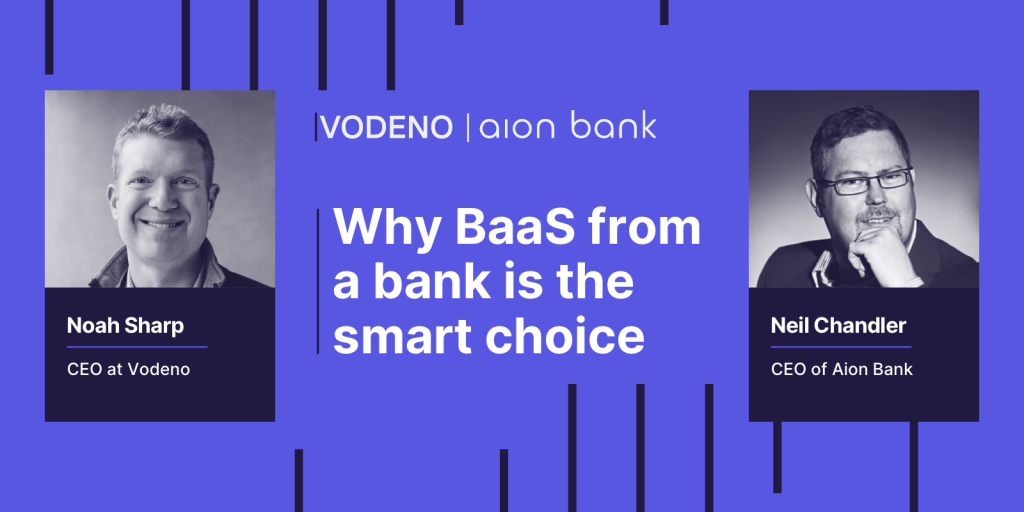The mobility sector is on the brink of a radical shift, with embedded finance transforming the way people and goods move from A to B.
“The mobility industry is fascinating, and it’s perhaps the sector where the potential impact of embedded finance is greatest,” explains Jean-Jacques Le Bon, Vodeno’s Chief Strategy and Product Officer.

Will how we travel, access transport, and manage logistics be reimagined as a result of embedded finance? Here are our five predictions:
Ease of cross-border payments
Payments can be a major challenge for mobility businesses, especially those operating internationally. Many still rely on outdated payment infrastructure, resulting in lengthy settlement times and added costs. But, embedded finance (EF) offers a solution to this problem.

By directly integrating payment solutions powered by a Banking-as-a-Service (BaaS) provider like Vodeno into their platforms, mobility businesses can facilitate seamless cross-border payment and settlement. It streamlines payment processing by removing middlemen, while providing the opportunity to reduce transaction costs through access to competitive rates and lower fees via direct partnerships.
Mobility companies like Uber and Lyft were among the first to embrace embedded payment solutions to enhance their customer journey, and, today, have expanded their EF strategies to create a better experience for their gig workers – we anticipate EF to unlock more use cases in the mobility sector following the lead of these innovators.
B2C and B2B applications
Mobility companies can use EF solutions to solve very particular pain points experienced by their customers, vendors, or employees.

As discussed, Uber was one of the first companies to offer bank accounts for drivers, accessible within the Uber app. Uber Money lets drivers see all their finances in one place, get faster access to earnings, and even offers products to help save and invest – this significantly improves the way they are able to manage their finances. Uber Money is a great example of how EF makes the customer experience better, and as a result, drives loyalty.
We will see much more of this, with mobility firms embracing the full range of BaaS-enabled EF solutions to deliver more accessible financial products and services – ones that are customised to the specific needs of their users. By doing so, these companies will simultaneously create stronger relationships with customers and partners, as well as generate new revenue streams.
Innovation and flexibility at checkout

Across all sectors, not least eCommerce and marketplaces, businesses are integrating solutions such as Buy Now, Pay Later (BNPL) within the checkout process. Mobility will follow suit, with more and more businesses providing customers with greater flexibility for their purchases.
For train operators and airlines, for instance, this allows customers to benefit from lower prices by booking earlier and then staggering payments over time. We will see much more of this in the short and medium term.
The rise of aggregators
The first three points concern specific ways mobility businesses can leverage EF, but there are broader shifts in motion.

Most notably, we are likely to see a rise in aggregators that will make access to travel completely frictionless. From the minute a person leaves their front door, they will be able to use a single app to hire an eBike to ride to the train station, purchase and scan a train ticket, and then take a bus at the other end to get to their destination.
“We’re moving towards the notion of global mobility, where people can go seamlessly from one mode of transport to another,” says Le Bon. “BaaS and embedded finance will be instrumental in powering these aggregators, and not just in facilitating payments for multiple mobility services. Customised offers, loyalty programmes, accounts and cashback will all become embedded in aggregators’ platforms to dramatically enhance the customer experience.”
- Cities to enhance their appeal through EF-powered mobility
Aggregators will unlock a new future for mobility, and both the private and public sectors will take note. Together, mobility businesses and local governments will jump at the opportunity to make destinations more appealing and accessible by offering a single place to access a person’s travel needs, further enhancing this offering through additional financial products and services.
Just as we are seeing in retail, mobility powered by EF will amplify the user experience, in turn encouraging people to spend more and return to that destination more often.

There’s more. As cities and governments around the world strive to become more sustainable, a transformed mobility sector connected by powerful aggregators can make a huge difference. Imagine discounted rates for green travel options, carbon offsetting functionality and incentives to spend money with eco-friendly retailers and hospitality venues in the city, all underpinned by BaaS and EF.
This trend is already taking shape. “The world is not all moving at the same speed,” explains Le Bon. “This vision of joined-up mobility and financial services already exists in a number of places, such as Hong Kong. You can buy a pass for transport across the city, but it also gives you access to special deals, payments at different locations, and more. Previously, this would have required 10 or 20 different cards and codes, but now it can all be done via one app on the smartphone in your pocket.”
Do you want to learn more about how Banking-as-a-Service and embedded finance can transform your business or industry? Then get in touch with Vodeno today.



